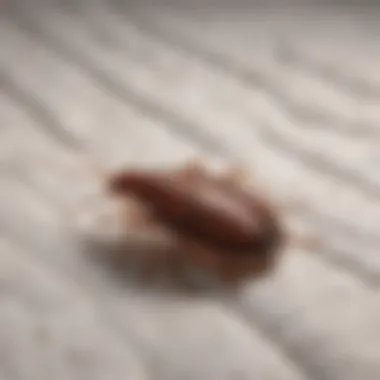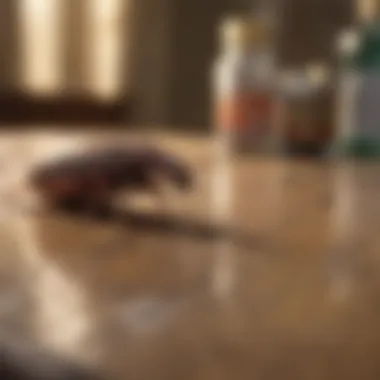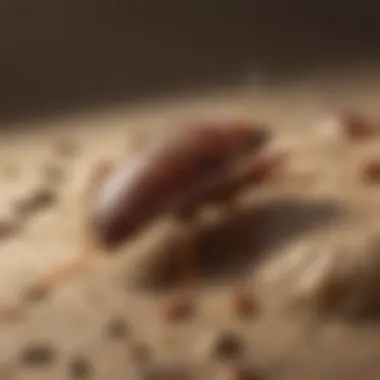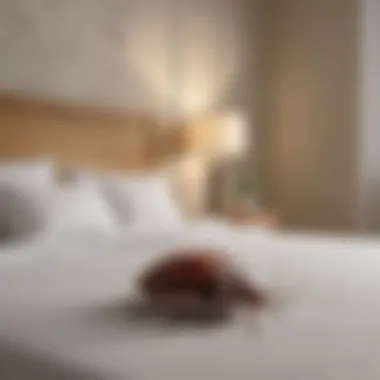Natural Methods for Effective Bed Bug Removal


Intro
The increase in bed bug infestations has raised concerns for households and businesses. Understanding these pests is essential for implementing effective removal strategies. Many seek natural methods that do not rely on harsh chemicals. Therefore, it is crucial to discover and understand the behaviors and habitats of these pests.
Understanding the Pest
Identification
Bed bugs, or Cimex lectularius, are small, oval, brownish insects. They grow to about the size of an apple seed. Adult bed bugs are visible to the naked eye. Nymphs are smaller and more difficult to see, often blending into surroundings.
They have a characteristic flattened body and are known for their ability to hide in small cracks and crevices. Common hiding spots include mattresses, bed frames, furniture, and within the seams of luggage. Identifying these bugs early is key to controlling their populations.
Life Cycle
The life cycle of bed bugs includes several stages: egg, nymph, and adult.
- Eggs: Female bed bugs can lay hundreds of eggs over their lifetime, often in hidden areas. These eggs are white and about the size of a pinhead.
- Nymphs: After about a week, the eggs hatch. Nymphs are small and require a blood meal to develop through five molting stages before reaching adulthood.
- Adults: The entire process from egg to adult can take four to six weeks under optimal conditions. This rapid reproduction contributes to their ability to establish large populations quickly.
Pest Prevention Strategies
Environment Modification
Making changes to the environment can help reduce the likelihood of infestations. Regular cleaning is essential. Dusting and vacuuming help remove potential hiding spots.
Here are some strategies to consider:
- Seal cracks: Fill in cracks and crevices in walls and around windows.
- Reduce clutter: Limit places where bed bugs can hide.
- Heat treatments: Use high temperatures to kill these pests. Washing bedding and personal items in hot water is effective.
- Monitor areas: Use bed bug interceptors under bed legs for early detection.
Physical Barriers
Using physical barriers can also prevent bed bugs from accessing sleeping areas.
- Encase mattresses: Protective encasements can trap bugs and prevent access to the mattress.
- Limit movement: Avoid placing bags on beds and reduce direct contact with potential infested items.
Control Methods
Chemical Control
While natural methods are preferred, some chemical solutions are available. However, they should be used responsibly. Products like diatomaceous earth can be beneficial. This natural powder dehydrates bed bugs upon contact.
Biological Control
There are biological methods that involve using natural predators. Beneficial insects like certain beetles can help manage populations.
"Natural pest control methods are gradually gaining acceptance among those wary of chemical pesticides."
Utilizing these methods may complement other strategies for effective management of infestations.
Closure
Understanding bed bugs and their behaviors is vital. Nature-based solutions can offer effective ways to manage and remove these pests. By combining proactive prevention and specific control methods, individuals can maintain their spaces free from infestations. This comprehensive understanding not only fosters a more informed approach but also promotes safer environments without heavy reliance on toxic substances.
Understanding Bed Bugs
Understanding bed bugs is essential for effective management and removal. These pests have become a common issue in homes and businesses, creating discomfort and distress. Awareness of their biology, behavior, and identification can significantly aid in controlling their presence. By gaining insights into these aspects, individuals can take proactive measures to eliminate these insects and prevent future infestations.
Biology of Bed Bugs
Bed bugs, scientifically known as Cimex lectularius, are small, parasitic insects that feed solely on the blood of humans and other warm-blooded animals. Adult bed bugs typically measure about 4 to 5 mm in length and have a flat, oval body that can swell after feeding. Their coloration ranges from light brown to reddish-brown, which often changes post-feeding.
They are known to produce eggs that are about 1 mm long, resembling small grains of rice. A mature female can lay approximately 200 to 500 eggs in a lifetime. These eggs hatch in about 6 to 10 days, leading to rapid population increases if an infestation goes unchecked. Understanding this lifecycle highlights the importance of early detection and intervention.
Behavioral Patterns


Bed bugs are primarily nocturnal creatures, which means they prefer to be active at night. This behavior allows them to feed when their hosts are asleep, making it harder for individuals to notice their presence.
Moreover, bed bugs are skilled at hiding. They tend to nest in tiny crevices and cracks near sleeping areas, such as mattresses, headboards, and bed frames. They can remain dormant for long periods, sometimes up to several months, without feeding. This resiliency contributes to their prevalence in various environments, including hotels and residential homes. Being aware of their behavioral patterns can help in targeting areas for inspection and treatment.
Signs of Infestation
Detecting bed bugs early is crucial for effective removal. Common signs of infestation include:
- Bite Marks: Red, itchy welts on the skin, often in clusters, typically indicate recent feeding.
- Fecal Stains: Small dark spots on bedding or upholstered furniture, often confused with ink stains.
- Egg Casings: Tiny, shell-like remnants found near nesting areas.
- Musty Odor: A sweet, unpleasant smell from large infestations, due to pheromones released by the bugs.
If any of these signs are noticed, immediate action should be taken to assess and treat the infestation.
"Early detection is the key to controlling bed bugs effectively and preventing widespread infestations."
By understanding the biology, behaviors, and signs of bed bugs, homeowners can better equip themselves to tackle these pests head-on. Such knowledge not only empowers direct action but also encourages vigilant practices to safeguard living spaces from future invasions.
Assessing the Infestation
Assessing the infestation of bed bugs is a critical first step in the process of elimination. Understanding how to effectively identify and assess the situation can save time, effort, and resources. It allows homeowners to tailor their removal strategies, ensuring that they are addressing the issue effectively.
The importance of this section lies in its ability to empower individuals with knowledge. When they know where to look and what signs to identify, it becomes easier to determine the magnitude of the problem.
Identifying Infested Areas
To begin identifying infested areas, one should examine common harborage sites. These include:
- Mattresses and Box Springs: Check seams, folds, and underneath.
- Bed Frames and Headboards: Look at joints and crevices.
- Furniture: Couches, chairs, and nightstands can harbor bed bugs.
- Walls and Baseboards: Inspect for dark spots which indicate droppings.
- Electrical Outlets: Bed bugs may hide in outlet covers.
Paying close attention to these areas is essential. Moving furniture may expose hidden bed bugs and their eggs. A flashlight can aid in inspection, revealing concealed spots. It is beneficial to conduct inspections regularly, especially in known infested areas.
Establishing the Severity
Establishing the severity of an infestation involves understanding various elements:
- Number of Bed Bugs Found: Finding a few may indicate a mild infestation; many signal a more severe situation.
- Life Stages of Bed Bugs: Eggs, nymphs, and adults should be examined in various locations.
- Frequency of Bites: If one is experiencing regular bites, this suggests a significant population.
- Spread to Adjacent Rooms: Check if nearby rooms show signs of bed bugs, which indicates a larger problem.
Tracking the severity can help determine the right course of action. A detailed log of findings may be beneficial. This can also inform any potential professional interventions if necessary.
"Identifying infested areas and understanding the severity are essential components of effective bed bug management."
Natural Removal Techniques
Natural removal techniques are essential because they offer eco-friendly alternatives to chemical treatments. These methods often rely on easily accessible materials and techniques that minimize harm to the environment and human health. They empower homeowners to take control of their living spaces without resorting to potentially toxic substances. The benefits of natural removal strategies include cost-effectiveness, reduced health risks, and the ability to act swiftly in response to an infestation. Understanding these techniques is crucial for effective bed bug management, particularly when traditional methods may not be viable or desired.
Heat Treatment Methods
Professional Heat Treatments
Professional heat treatments are a widely recognized method for addressing bed bug infestations. This technique involves heating an affected area to a temperature lethal to bed bugs, typically around 120°F (49°C). The effectiveness of this method lies in its comprehensive reach; it can eradicate all life stages of bed bugs, including eggs. A key characteristic of professional heat treatments is the use of specialized equipment that can uniformly distribute heat throughout an area. This is a beneficial choice for those dealing with severe infestations. However, the cost of professional services can be significant, and not all situations may warrant such an investment.
DIY Heat Applications
DIY heat applications can be an accessible option for individuals looking to manage bed bug populations on their own. This method usually involves using home appliances, such as steamers or heat guns, to treat infested furniture or bedding. A major advantage of DIY heat applications is the decreased cost involved, making it more feasible for homeowners. However, the key characteristic of this approach is the necessity for thoroughness. It can be challenging to ensure consistent heat exposure in all areas, which may lead to incomplete pest control. If not executed correctly, there is also a risk of damaging household items during the process.
Diatomaceous Earth
Application Strategies
Diatomaceous earth can be a powerful tool in the arsenal against bed bugs. This natural powder consists of fossilized algae, which is non-toxic to humans yet lethal to insects. Application strategies involve spreading the powder in targeted areas where bed bugs are likely to congregate, such as along baseboards and in cracks and crevices. The key characteristic of diatomaceous earth is its mechanical action to damage the exoskeleton of bed bugs, leading to dehydration and death. It is often favored for its safety and efficiency. However, applying it requires careful attention to areas that are hard to reach to ensure optimal effectiveness.
Effectiveness Analysis
The effectiveness of diatomaceous earth hinges on several factors, including proper application and environmental conditions. One significant aspect is that it works best in dry environments. If the area becomes wet, the powder can lose its insecticidal properties. This characteristic makes diatomaceous earth a beneficial option for those seeking an organic removal strategy. Nevertheless, its use might take longer to yield results compared to other methods, requiring patience and diligence in monitoring the situation.


Essential Oils for Repellence
Recommended Oils
Essential oils are gaining recognition as natural repellents against bed bugs. Oils such as tea tree, lavender, and peppermint possess properties that deter these pests. The effectiveness of essential oils stems from their strong scents, which are often intolerable to bed bugs. This makes them a popular choice for preventative measures. However, while essential oils can repel bed bugs temporarily, they may not eradicate established infestations. Their unique feature is their pleasant aroma, providing a more appealing alternative to harsh chemicals.
Application Methods
Application methods for essential oils can vary. Sprays made with diluted essential oils can be applied around suspected infested areas, and diffusers can also be used to spread the scent throughout a room. The key characteristic of these methods is their ease of use, allowing homeowners to incorporate them into regular cleaning routines. However, their effectiveness is sometimes limited, especially in severe infestations.
Vinegar Solutions
Types of Vinegar
Different types of vinegar offer various levels of effectiveness in dealing with bed bugs. White vinegar is the most commonly used option, known for its strong scent and acidic properties. Apple cider vinegar is another alternative, which is often favored for its natural ingredients. The key characteristic of vinegar solutions is their ability to disrupt the pests’ chemical signals, making it an unfavorable environment for them. While vinegar may not kill bed bugs outright, using it strategically can help manage populations in specific areas.
Usage Guidelines
Usage guidelines for vinegar solutions are straightforward yet important. A common method involves spraying undiluted vinegar directly onto bed bugs or infested surfaces. It is effective when applied consistently. However, users should be cautious as vinegar can damage certain fabrics and surfaces if not tested first. This makes vinegar a potential choice for those looking for a low-cost, natural remedy but requires some level of care in application.
Boric Acid
Safe Application Techniques
Boric acid acts as a potent agent against bed bugs due to its desiccant properties. Safe application techniques involve using small amounts applied in cracks, crevices, or hidden corners where bed bugs may hide. The key characteristic of boric acid is its ability to absorb moisture, leading to the dehydration of the pests. This method allows for effective control when applied judiciously, often making it a favorite for those concerned with other methods’ potential toxicity. Care must be taken to avoid areas frequented by pets or small children due to safety concerns.
Mechanism of Action
The mechanism of action for boric acid involves disrupting the insects' digestive systems, ultimately leading to death. Its low toxicity to humans compared to its potency against insects makes it a valuable choice for natural removal methods. A unique aspect is its persistence; when applied correctly, it can remain effective for a long time. The limitation, however, lies in its reliance on the bed bugs coming into contact with the treated areas, which may not happen if the pests are in less accessible locations.
Cleaning Protocols
Cleaning protocols serve as a fundamental aspect of any strategy aimed at eliminating bed bugs. These methods address the infestation directly, removing existing bugs and their eggs from various surfaces. The benefits of maintaining a rigorous cleaning routine are manifold. It not only reduces pest populations but also helps prevent future infestations.
One of the significant considerations in developing effective cleaning protocols is understanding that bed bugs can inhabit a variety of locations beyond just mattresses and linens. They can also be found in carpets, furniture, and even inside small crevices. Therefore, a comprehensive cleaning approach is necessary to enhance the likelihood of successful removal.
Regular cleaning practices—specifically washing fabrics and vacuuming spaces—create an inhospitable environment for bed bugs. Additionally, these actions disrupt their life cycle, particularly when performed with properly defined methodologies. In this section, we will discuss specific techniques that can greatly assist in your battle against these resilient pests.
Laundering Infested Fabrics
Laundering infested fabrics is an essential step in your cleaning protocol. Hot water effectively eliminates bed bugs and their eggs. It is important to wash all infested items, including bed linens, clothing, and curtains. Using water that reaches a minimum temperature of 120°F (49°C) is most effective.
To maximize the effectiveness of laundering, follow these tips:
- Separate infested items: Before washing, isolate infested fabrics in a sealed plastic bag to prevent spreading.
- Use high temperatures: Drying items on high heat for at least 30 minutes is also necessary after washing to kill any remaining bugs.
Additionally, not all fabrics can withstand high heat, so check care labels. Some items may require special handling, like dry cleaning. Attending to fabric care ensures you do not unintentionally damage your belongings while eliminating bed bugs.
Vacuuming Strategies
Vacuuming is another critical practice while combating bed bugs. It can be effectively employed to remove adult bugs and eggs from surfaces, including carpets, furniture, and hard-to-reach corners.
Optimal Vacuum Settings
Optimal vacuum settings play a pivotal role in facilitating the removal of bed bugs. Using a vacuum equipped with a HEPA filter is advisable. These filters effectively trap microscopic bugs and allergens, ensuring a cleaner environment.
Choosing the right setting for the type of surface being cleaned proves beneficial as well. For carpets, using a brush attachment helps dislodge eggs and bugs that may be embedded deep within the fibers. Keep in mind that not all vacuums are equipped to handle this task effectively. Review your vacuum's specifications and maintain it regularly for best outcomes.
Post-Vacuum Procedures
Post-vacuum procedures are just as crucial as the vacuuming itself. After you have finished vacuuming, it is essential to dispose of the vacuum bag or empty the canister outside immediately. This action prevents any captured bugs from escaping and re-infesting your home. Additionally, thorough cleaning of the vacuum itself helps remove any remnants that may linger.
Creating a habit of emptying and cleaning your vacuum after each use can significantly reduce bed bug populations in your living space. Take a moment to wash the vacuum's brush rollers and attachments regularly to maintain their effectiveness.


Steam Cleaning Techniques
Steam cleaning techniques provide yet another layer of protection against bed bugs. The high temperatures reached in steam cleaning will effectively kill bugs and their eggs upon contact. Ensure that the steam cleaner reaches a temperature of at least 130°F (54°C) to achieve optimal results.
Focus on areas where bed bugs are likely to hide, such as mattress seams, carpets, and even upholstered furniture.
In summary, effective cleaning protocols are a vital component in the holistic management of bed bug infestations. Through laundering, vacuuming, and steam cleaning, you establish a solid foundation that curtails bug populations. By committing to these practices, you enhance the overall effectiveness of your natural removal strategy.
Prevention Strategies
Prevention is a critical aspect of managing bed bug issues. Effective prevention strategies can significantly reduce the chances of an infestation. This section will cover essential measures that every homeowner or housewife should implement to keep their living spaces bug-free. Focusing on these strategies not only avoids the discomfort and frustration of a bed bug presence, but also saves time and money in the long run.
Sealing Entry Points
Sealing entry points is one of the simplest yet most effective methods to prevent bed bugs from entering your home. Bed bugs can exploit the smallest of gaps. They can travel through cracks in walls and gaps around doors and windows. To minimize this risk, consider the following actions:
- Inspect Windows and Doors: Use caulk or weather stripping to seal gaps. Check any cracks in the frames.
- Patch Holes: Look for holes in walls, especially near plumbing and electrical outlets, and use appropriate fillers.
- Install Screens: Door and window screens can act as a barrier while allowing ventilation.
Taking these steps can create a more inhospitable environment for bed bugs and discourage their entry into your space.
Regular Inspections
Regular inspections are vital in detecting bed bugs before they become a significant issue. Early detection can save a homeowner from extensive damage and stress. Here's how to conduct effective inspections:
- Bed and Bedding Check: Carefully look at seams of mattresses, bed frames, and headboards. Bed bugs often hide in these areas.
- Furniture Inspection: Inspect upholstered furniture, as well as any cracks or crevices in the wood.
- Luggage and Bags: After traveling, always check luggage and bags before bringing them inside your home.
By incorporating inspections into your routine, you can identify potential problems early on. This proactive approach can be crucial in preventing the spread of bed bugs throughout your home.
Educating Household Members
Educating everyone about bed bug prevention is essential. It creates a united front against infestations. Here are key points to cover when discussing this topic with family or housemates:
- Recognizing Signs of Infestations: Make sure they know what to look for, including bites, shed skins, and live bugs.
- Proper Laundering Practices: Teach proper washing and drying techniques to ensure infested items do not return to general use.
- Travel Precautions: Discuss safe practices when traveling, such as inspecting hotel rooms and keeping luggage off the floor.
By fostering a culture of awareness and prevention, household members can contribute to a significant reduction in the risk of bed bug infestations.
Limitations of Natural Methods
Natural methods often lack the immediacy and effectiveness that chemical treatments may offer. In cases of significant infestations, relying solely on DIY methods can prolong the problem. Professionals have access to advanced techniques and tools that can neutralize bed bugs more efficiently.
Situations Requiring Professional Help
In certain scenarios, it becomes necessary to call in experienced pest control professionals. Examples include:
- Severe Infestations: If the bed bug population has rapidly increased, it is time for professional assistance. They can assess the situation and determine the best strategies for eradication.
- Multiple Areas Affected: Bed bugs may not reside solely in one location. If infestations are found in various parts of the home, professional intervention is essential.
- Lack of Time: Some households may not have the time or resources to manage the removal process effectively. Hiring specialists can save both time and stress.
- Health Concerns: If anyone in the household has allergies or respiratory conditions, natural methods may not eliminate the pests adequately, posing health risks.
"Don’t underestimate the potential severity of an infestation. Sometimes, a combined approach leveraging both natural methods and professional help yields the best results."
Potential Risks of DIY Methods
Although DIY methods can be effective under controlled conditions, they also come with risks:
- Incomplete Elimination: DIY techniques might not reach all hiding spots of bed bugs, leaving behind eggs or adults to multiply.
- Time Investment: Homeowners may find themselves spending excessive amounts of time trying to resolve the issue, which can be frustrating.
- Incorrect Use of Products: Mismanagement of natural substances like boric acid or essential oils can lead to ineffectiveness or potential harm.
- False Sense of Security: Relying solely on natural methods can lead to complacency. Without regular monitoring, the infestation might escalate unnoticed.
In summary, while natural methods are valuable for addressing bed bugs, awareness of their limitations is essential. This understanding helps households make informed decisions on when to use these methods versus when to seek professional services.
Epilogue
Employing eco-friendly methods, such as heat treatments and natural repellents, not only helps in removing the pests but also lowers the environmental impact. Furthermore, when individuals actively engage in their pest management, they become better informed about these creatures, improving their chances of successfully preventing future infestations.
Understanding and maintaining cleanliness is crucial. Regular inspections and responding quickly can prevent a minor issue from evolving into a severe infestation.
Summary of Key Points
- Natural methods effectively target bed bugs, presenting safer alternatives compared to synthetic pesticides.
- Key methods include heat application, diatomaceous earth, and essential oils, each having individual effectiveness and application strategies.
- Regular cleaning practices, such as vacuuming and laundering, offer necessary preventative measures against reinfestation.
- The article provides a holistic approach to managing bed bugs, blending removal strategies with efficient prevention techniques.
- Recognizing situations that necessitate professional intervention ensures a thorough response to severe infestations.
Final Thoughts
In sum, navigating a bed bug infestation can be daunting. However, armed with knowledge about natural removal techniques, individuals can confidently tackle the problem at hand. These methods not only enhance the immediate living environment but also foster long-term peace of mind through consistent preventive practices. The journey to pest-free living does not have to rely solely on chemicals; rather, it can be approached naturally and more sustainably.







